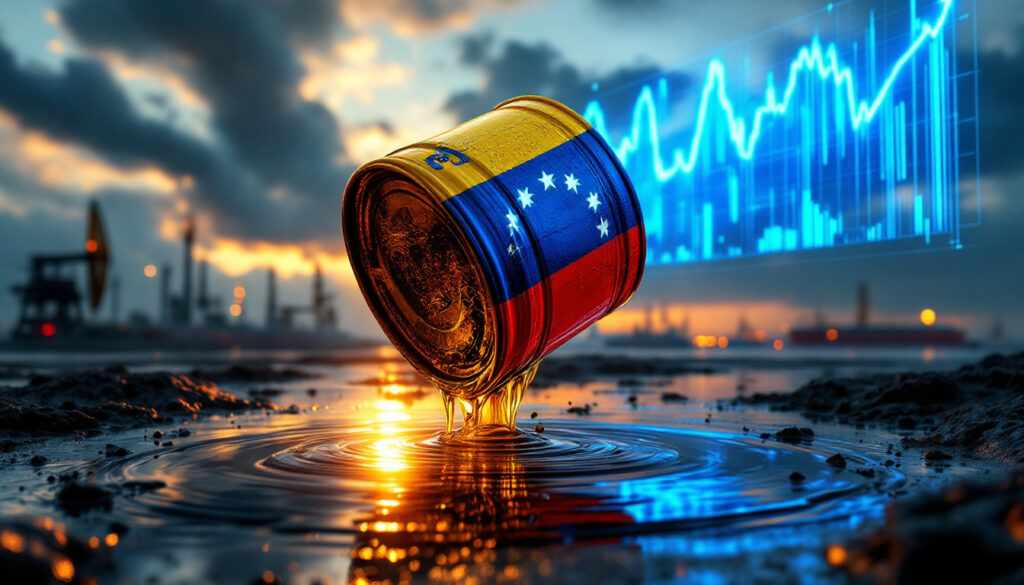How Do Oil Prices Respond to Venezuela Tariffs?
Oil prices have shown significant volatility following the implementation of secondary tariffs on Venezuelan oil purchases. When President Trump announced a 25% secondary tariff on countries buying Venezuelan oil or gas in March 2025, markets responded immediately. WTI crude climbed near $70 per barrel while Brent reached $73.89, demonstrating the global market's sensitivity to policy changes affecting major oil producers.
According to energy analyst Alex Kimani, "These secondary tariffs represent one of the most aggressive economic tools deployed against Venezuela's oil sector, effectively creating a global penalty for any nation continuing to purchase Venezuelan crude."
Understanding Trump's Venezuela Oil Tariff Policy
What Are the Secondary Tariffs?
The 25% secondary tariff targets countries purchasing Venezuelan oil or gas, creating significant consequences for major buyers including China, India, Spain, Italy, and Cuba. This policy tool aims to pressure Venezuela's Maduro regime by disrupting its primary revenue stream from oil exports.
The tariffs represent an escalation of previous sanctions, specifically designed to isolate Venezuela's energy sector from international markets. Secretary of State Marco Rubio emphasized this point, stating, "Every barrel of Venezuelan oil purchased provides direct financial support to the Maduro regime's oppressive policies and human rights violations."
Unlike primary sanctions that directly target Venezuelan entities, these secondary tariffs place economic penalties on third-party countries continuing to trade with Venezuela, creating a multilayered approach to diplomatic pressure.
Timeline of Implementation
Trump's energy policies took a decisive turn with the March 2025 announcement, setting a rapid implementation schedule. Chevron, the last major U.S. oil company operating in Venezuela, received just a 30-day notice to conclude operations by April 3rd. This abbreviated timeline represents a significant departure from the typical six-month wind-down period granted under previous sanctions regimes.
The aggressive timeline signals an intensification of U.S. policy toward Venezuela, following years of graduated sanctions against the nation's oil sector. Market analysts note that the compressed exit schedule created logistical challenges for companies with Venezuelan operations and accelerated market volatility explained by uncertainty about supply disruptions.
Impact on Global Oil Markets
Price Movements and Market Response
Following the tariff announcement, oil markets responded with immediate price increases. WTI crude gained 1.2% to $69.84 per barrel, while Brent crude for May delivery climbed 1.2% to $73.89. Despite prevailing bearish sentiment in broader markets, oil prices maintained levels above $70 per barrel, reflecting the significance of the policy shift.
Interestingly, speculative positioning revealed a market dynamic where traders remained predominantly on the short side despite the bullish price movement, indicating lingering uncertainty about longer-term impacts. Commodity trading advisors (CTAs) maintained significant short positions in both crude and refined products, creating potential for sharp upward price corrections if positions were unwound rapidly.
Supply Chain Disruptions
The tariffs are triggering significant realignments in global commodity shifts as countries formerly purchasing Venezuelan crude seek alternative suppliers. The estimated 735,000 barrels per day of Venezuelan production now face restricted market access, creating opportunities for producers in the U.S., Middle East, and non-sanctioned Latin American countries.
Chevron's operations previously accounted for approximately 20% of Venezuela's total oil production in early 2024. The company's forced exit removes a significant portion of Venezuela's already diminished production capacity, which has dramatically declined from 3.2 million barrels per day in 2000 to just 735,000 barrels per day by 2023.
Venezuela's Oil Production Challenges
Historical Production Decline
Venezuela's production trajectory illustrates a dramatic collapse in the country's oil sector. Output has plummeted from 3.2 million barrels daily in 2000 to 735,000 barrels per day in 2023—a 77% decline over two decades. This deterioration stems from a combination of international sanctions and chronic underinvestment in infrastructure maintenance.
The state-owned oil company PDVSA has struggled with technical challenges, lack of capital investment, and corruption issues that have accelerated the production decline. Industry experts note that Venezuela's oil fields require specialized technology and expertise to maintain productivity, resources that have become increasingly scarce under sanctions.
Despite President Maduro's stated goal of reaching 1 million barrels per day, the latest tariffs and Chevron's exit make this target virtually unattainable. Petroleum engineers familiar with Venezuela's oil fields estimate that without significant investment, natural decline rates will further reduce production by 10-15% annually.
Political and Economic Context
U.S. sanctions have explicitly targeted President Nicolás Maduro's regime since 2019, with policy statements citing concerns about democratic processes and human rights. Secretary Rubio's comments about Chevron providing financial support to Maduro highlight the political dimension of these economic measures.
The sanctions strategy represents a calculated attempt to pressure Venezuela's leadership on civil rights issues by targeting the country's primary source of foreign currency. Venezuela's economy remains heavily dependent on oil revenues, with petroleum exports accounting for approximately 95% of export earnings before sanctions intensified.
The tariffs represent an escalation of economic pressure tactics, moving beyond direct sanctions to penalize third-party countries continuing to trade with Venezuela.
Global Oil Demand Outlook
Current Demand Fundamentals
Despite market concerns, global oil demand shows remarkable resilience. According to Standard Chartered analysis, demand averaged 102.77 million barrels per day in January 2025, representing a substantial 2.19 million barrel per day year-on-year increase.
Forecasts suggest continued growth, with demand expected to surpass 105 million barrels per day by June 2025 and reach a seasonal peak of 105.6 million barrels per day in August. This growth trajectory contradicts broader market sentiment that has focused on potential demand destruction.
The strength in emerging market demand has particularly surprised analysts, with countries across Asia and parts of Latin America showing consumption growth despite economic headwinds. Transportation and petrochemical sectors continue driving fundamental demand increases across developing economies.
Factors Supporting Oil Prices
Several factors provide structural support for oil prices and tariffs on Venezuela beyond the immediate impact of these sanctions. Market analysis suggests current prices undervalue geopolitical risk premiums, creating potential for upward price corrections as supply uncertainties persist.
Inventory data presents a bullish indicator, with U.S. crude and product inventories showing consistent declines. Additionally, U.S. shale production has delivered weaker-than-expected output, undermining expectations of robust supply growth from North American producers.
The combination of these factors suggests underlying market strength, with demand projected to outpace supply during the second and third quarters of 2025. This fundamental tightness provides a supportive backdrop for prices despite broader macroeconomic concerns.
Market Expert Perspectives
Analyst Forecasts
Standard Chartered projects full-year oil demand growth of 1.41 million barrels per day, reflecting continued economic expansion across key consumption regions. This contrasts with Goldman Sachs' more bearish outlook, which recently reduced price projections amid oversupply concerns.
The divergence in analyst perspectives highlights uncertainty about how secondary tariffs will influence global trade patterns and ultimate supply-demand balances. However, several analysts note that current market prices appear oversold relative to fundamental indicators, suggesting potential for upward corrections.
Many industry experts predict that demand will outpace supply during the middle quarters of 2025, creating inventory drawdowns and supportive price dynamics despite geopolitical complications.
Potential Risks to Market Stability
The tariff policies create several potential risks to market stability. First, they could negatively impact global demand if they contribute to broader trade tensions or economic slowdowns. Second, shifting U.S. policy toward other producers like Russia could create additional supply uncertainties.
Market sentiment remains cautious despite strong fundamental indicators, reflecting concerns about policy unpredictability and potential retaliation from affected countries. The continued geopolitical tensions surrounding Venezuela could trigger further supply chain disruptions as trade patterns adjust to policy constraints.
How Will Venezuela Tariffs Affect Global Trade Patterns?
Reshaping International Oil Flows
The tariffs target major Venezuelan oil purchasers including China, India, Spain, Italy, and Cuba. These countries now face challenging decisions about their energy supply chains, weighing continued access to Venezuelan crude against potential tariff penalties.
China, as Venezuela's largest remaining customer, faces particular exposure to these measures. Industry analysts expect Chinese refiners to seek alternative medium and heavy crude sources from the Middle East, potentially increasing competition for these grades and supporting their price premiums.
India's refineries, which have occasionally purchased Venezuelan barrels when price discounts were attractive, will likely increase imports from other Latin American producers and Middle Eastern suppliers. European buyers in Spain and Italy must similarly reconsider their Venezuelan purchases, potentially increasing their reliance on North African and Middle Eastern alternatives.
Cuba presents a special case, as the island nation depends heavily on Venezuelan oil through preferential supply arrangements. With limited alternatives and economic constraints, Cuba faces potential energy shortages unless it can secure new supply partnerships.
Economic Implications of Secondary Tariffs
The implementation of secondary tariffs raises significant questions about international trade law and World Trade Organization compliance. The use of tariffs as a foreign policy tool against third-party countries creates precedents that could reshape international economic relationships.
Diplomatic tensions may rise with nations dependent on Venezuelan oil, particularly if they perceive the tariffs as infringing on their sovereignty in making independent trade decisions. The policy could complicate multilateral efforts on other international issues where cooperation with affected nations is essential.
The oil market faces increased volatility and compliance costs as traders navigate the complex regulatory environment. International oil companies must evaluate their exposure to both Venezuelan business relationships and potential secondary sanction risks, creating additional operational challenges.
FAQ: Venezuela Oil Tariffs and Market Impact
What exactly did President Trump announce regarding Venezuelan oil?
President Trump announced a 25% secondary tariff on any country that purchases oil or gas from Venezuela. This policy effectively penalizes nations that continue to buy Venezuelan petroleum products by imposing additional costs on their U.S. trade relationships.
Which countries will be most affected by these secondary tariffs?
The main buyers of Venezuelan oil targeted by these tariffs include China, India, Spain, Italy, and Cuba. These countries now face the choice of either continuing to purchase Venezuelan oil and paying additional tariffs on their U.S. trade or finding alternative suppliers.
How has Chevron's operation in Venezuela been affected?
Chevron received a 30-day notice from the Trump administration to cease operations in Venezuela by April 3, 2025. This timeline is significantly shorter than the usual six-month wind-down period typically granted under sanctions policy. Chevron had been producing approximately 20% of Venezuela's oil under a special waiver from previous U.S. sanctions.
What has happened to Venezuela's oil production over time?
Venezuela's crude oil production has declined dramatically from 3.2 million barrels per day in 2000 to approximately 735,000 barrels per day by September 2023. This decline is attributed to both international sanctions and poor maintenance of oil infrastructure under the state oil company PDVSA.
How have oil prices responded to the tariff announcement?
Following the announcement, oil prices rallied with WTI crude climbing 1.2% to $69.84 per barrel and Brent crude gaining 1.2% to reach $73.89 per barrel. Despite bearish market sentiment in other sectors, oil prices have remained relatively stable above the $70 per barrel threshold, reflecting the market's assessment of supply risks.
What is the current outlook for global oil demand?
According to Standard Chartered analysts, global oil demand remains strong at 102.77 million barrels per day as of January 2025, representing a 2.19 million barrel per day year-on-year increase. Demand is forecast to exceed 105 million barrels per day by June and peak at 105.6 million barrels per day in August 2025, indicating robust consumption despite economic uncertainties.
Investors considering exposure to this sector should carefully evaluate geopolitical investment strategies and potential impacts on the emerging commodity super cycle that many analysts believe is underway.
Want to Spot the Next Major Resource Discovery Before the Market Does?
Stay ahead of the investment curve with real-time alerts on significant ASX mineral discoveries through Discovery Alert's proprietary Discovery IQ model, transforming complex exploration data into actionable investment insights. Explore how major discoveries have historically delivered exceptional returns by visiting Discovery Alert's dedicated discoveries page and position yourself to capitalise on the next market-moving announcement.




